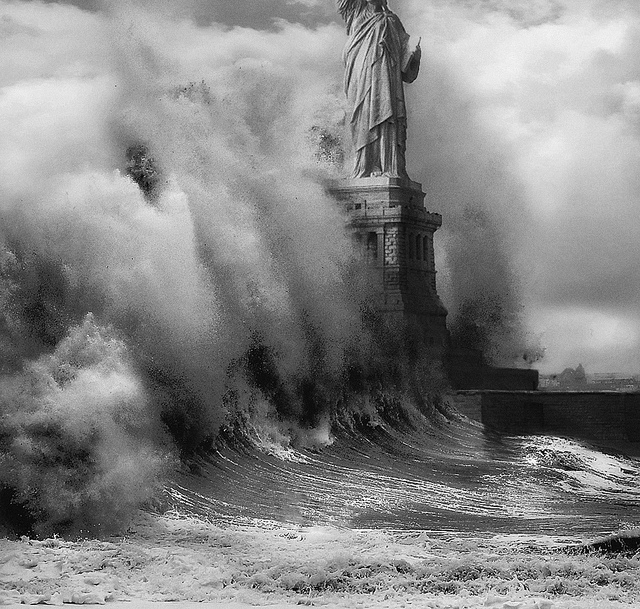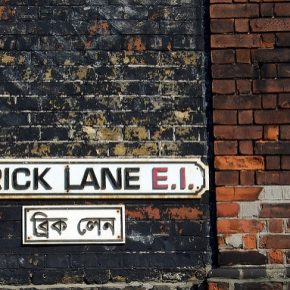Kim Stanley Robinson is the most insightful speculative futurist writer active today. In novels like 2312, the Science in the Capital series, and The Mars Trilogy, Robinson has built his trade on looking forward at how the events and conditions of the present might play out over the course of years, decades, and centuries.
His new novel, New York 2140 is a sort of ecological tract melded with a financial thriller set against the backdrop of a city (and a planet) in which the coastal areas have been inundated and forever transformed by sea level rises and global warming.
In the wake of two dramatic rises in the level of the seas, residents of Lower Manhattan live in constructed nodes on the flooded end of the island. Some of these are the melting remains of brownstones and tenement houses.
Others are skyscrapers, anchored in Manhattan bedrock, with the lower floor sealed and waterproofed to keep them sound and livable. The action of the book is
Others are skyscrapers, anchored in Manhattan bedrock, with the lower floor sealed and waterproofed to keep them sound and livable. The action of the book is centered on one such building, the former Met Life tower on what had been Madison Square.
The relationships of the city, and of the country at large, have been thrown into a state of flux by the sea’s rise, with the legal and economic status of the intertidal zone in flux. The action of the book is driven by this uncertainty and the ways that it becomes the subject of speculation by pools of capital. Indeed the underlying thrust of Robinson’s text is the illustration of the ways that capital escapes and ultimately colonizes the power of civil government.
Much as Robinson has a political point to make, his storytelling is by and large effective. He creates one of those tales in which a group of mismatched heroes is thrown together by circumstance and find a common purpose that surpasses and synthesizes their own individual goals and desires. This is an old story line, but none the worse for having been used before. Robinson makes effective use of it, crafting characters that become more than simply two-dimensional representations of the social functions that they embody.
As is generally the case with literature in the speculative futurist genre, the factors that are decisive for the narrative are also those that the author wishes to read back into our own time. Robinson’s concerns are not far to seek. The degradation of the environment is an omnipresent issue, not only in its effects on the living conditions and social structures of the character and the city in which they live but also in the world at large. At one point, one of the characters, a media personality who broadcasts live from her airship about ecological issues, ends up attempting to ferry endangered polar bears to safety at the south pole, only to have them slaughtered by environmental purists.
Perhaps of even more significance is Robinson’s investigation of the relationship between property, power, and capital. There are points at which you can tell what books he has read and found important in thinking about this book (certainly Ostrom’s Governing the Commons, more than likely Lewis’s The Big Short and/or Flash Boys just to name a couple).
Robinson wants to explore in literature the question of how it is that people down the income distribution line can reclaim some sort of power over their circumstances given the propensity of the economic system to generate Minsky Moments and their attendant (gigantic) payouts on bad leveraged bets. His answer is a complex mix of mass activism and technical expertise. By the end of the book, which will clearly be followed with subsequent volumes, this combination of tactics seems to be promising. The question remains and is certainly meant to be raised, as to whether this can work in today’s conditions.
I tend to think that Robinson is on to something. He’s probably right that, given the level of leveraging of banks, hedge funds, and other financial entities, the amount of noncompliance required to start a major crisis would not have to be that large. But he seems rather optimistic in his assumptions that such a movement would be able to find allies in the financial community willing to assist or even to stand idly by, even given the promise of massive short profits to be derived from a systemic crisis or collapse.
It is worth noting as well that the thing that allows anti-systemic sentiment of proper intensity to be generated is a natural disaster in New York of the sort that befell New Orleans, but much more cataclysmic in that it strikes near one of the central notes of finance capitalism.
One failing of the book, if you want to call it that, is that the last 150 pages or so starts to read more like an overtly political tract as some of the narrative framework slips away. Part of this is clearly setting up for subsequent volumes, but it also seems to involve a good deal of passing over problems of systemic resistance which would prove daunting.
Of course, and once again, this may get addressed at greater length as the story is continued. This, too, is what one might conclude when asking the question as to what sort of politics a notionally acephalus movement against capital might generate. Most people who are exploited have a pretty good idea of what they are against. Coming up with something that they are collectively for has generally been a more complicated problem, and dealing with the differences in goals has often had extremely unfortunate consequences for nascent revolutions.
Ultimately, New York 2140 does an effective job of melding these themes into a narrative that is both coherent and entertaining. As has so often been the case, Robinson has written a novel that effectively prefigures the likely outcomes of the currents of the present day. It will be interesting to see where he takes this narrative in the future.
Photograph courtesy of Gordon Tarpley. Published under a Creative Commons license.





